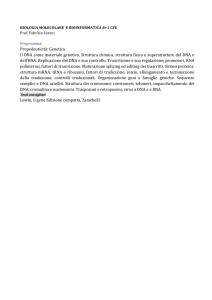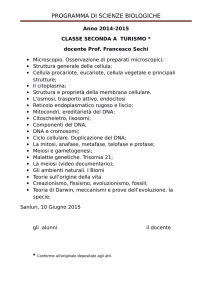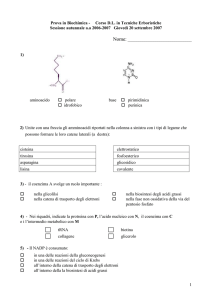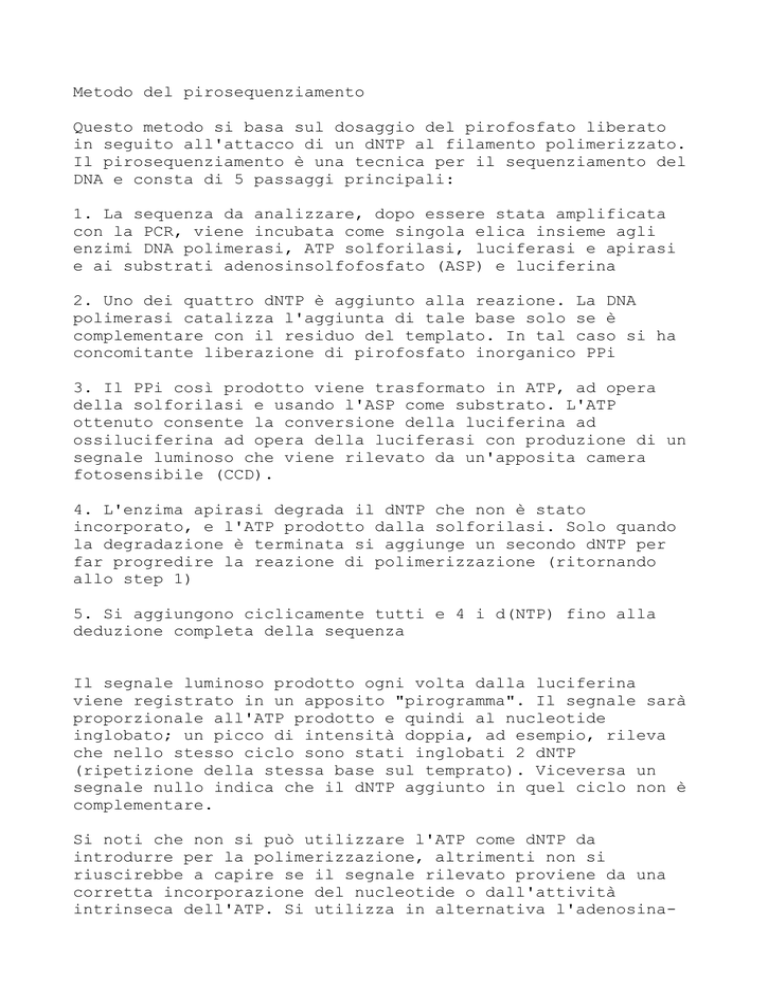
Metodo del pirosequenziamento
Questo metodo si basa sul dosaggio del pirofosfato liberato
in seguito all'attacco di un dNTP al filamento polimerizzato.
Il pirosequenziamento è una tecnica per il sequenziamento del
DNA e consta di 5 passaggi principali:
1. La sequenza da analizzare, dopo essere stata amplificata
con la PCR, viene incubata come singola elica insieme agli
enzimi DNA polimerasi, ATP solforilasi, luciferasi e apirasi
e ai substrati adenosinsolfofosfato (ASP) e luciferina
2. Uno dei quattro dNTP è aggiunto alla reazione. La DNA
polimerasi catalizza l'aggiunta di tale base solo se è
complementare con il residuo del templato. In tal caso si ha
concomitante liberazione di pirofosfato inorganico PPi
3. Il PPi così prodotto viene trasformato in ATP, ad opera
della solforilasi e usando l'ASP come substrato. L'ATP
ottenuto consente la conversione della luciferina ad
ossiluciferina ad opera della luciferasi con produzione di un
segnale luminoso che viene rilevato da un'apposita camera
fotosensibile (CCD).
4. L'enzima apirasi degrada il dNTP che non è stato
incorporato, e l'ATP prodotto dalla solforilasi. Solo quando
la degradazione è terminata si aggiunge un secondo dNTP per
far progredire la reazione di polimerizzazione (ritornando
allo step 1)
5. Si aggiungono ciclicamente tutti e 4 i d(NTP) fino alla
deduzione completa della sequenza
Il segnale luminoso prodotto ogni volta dalla luciferina
viene registrato in un apposito "pirogramma". Il segnale sarà
proporzionale all'ATP prodotto e quindi al nucleotide
inglobato; un picco di intensità doppia, ad esempio, rileva
che nello stesso ciclo sono stati inglobati 2 dNTP
(ripetizione della stessa base sul temprato). Viceversa un
segnale nullo indica che il dNTP aggiunto in quel ciclo non è
complementare.
Si noti che non si può utilizzare l'ATP come dNTP da
introdurre per la polimerizzazione, altrimenti non si
riuscirebbe a capire se il segnale rilevato proviene da una
corretta incorporazione del nucleotide o dall'attività
intrinseca dell'ATP. Si utilizza in alternativa l'adenosina-
tio-trifosfato, che è riconosciuta dalla DNA polimerasi come
se fosse ATP, ma non dalla luciferasi.
Pyrosequencing is a method of DNA sequencing (determining the
order of nucleotides in DNA) based on the "sequencing by
synthesis" principle. The technique was developed by Mostafa
Ronaghi and Pål Nyrén at the Royal Institute of Technology in
Stockholm in the 1990s.[1] [2][3]
Procedure
The method is based on detecting the activity of DNA polymerase with a chemiluminescent
enzyme. Essentially, the method allows sequencing of a single strand of DNA by
synthesizing the complementary strand along it, one base pair at a time, and detecting which
base was actually added at each step. The template DNA is immobilized, and solutions of A,
C, G, and T nucleotides are added sequentially. Light is produced only when the nucleotide
solution complements the first unpaired base of the template. The sequence of solutions
which produce chemiluminescent signals allows the determination of the sequence of the
template.
ssDNA template is hybridized to a sequencing primer and incubated with the enzymes DNA
polymerase, ATP sulfurylase, luciferase and apyrase, and with the substrates adenosine 5´
phosphosulfate (APS) and luciferin.
1. The addition of one of the four deoxynucleotide triphosphates (dNTPs) initiates the
second step. DNA polymerase incorporates the correct, complementary dNTPs onto the
template. This incorporation releases pyrophosphate (PPi) stoichiometrically.
2. ATP sulfurylase quantitatively converts PPi to ATP in the presence of adenosine 5´
phosphosulfate. This ATP acts as fuel to the luciferase-mediated conversion of luciferin to
oxyluciferin that generates visible light in amounts that are proportional to the amount of
ATP. The light produced in the luciferase-catalyzed reaction is detected by a camera and
analyzed in a program.
3. Unincorporated nucleotides and ATP are degraded by the apyrase, and the reaction can
restart with another nucleotide.
Currently, a limitation of the method is that the lengths of individual reads of DNA
sequence are in the neighborhood of 300-500 nucleotides, shorter than the 800-1000
obtainable with chain termination methods (e.g. Sanger sequencing). This can make the
process of genome assembly more difficult, particularly for sequence containing a large
amount of repetitive DNA. As of 2007, pyrosequencing is most commonly used for
resequencing or sequencing of genomes for which the sequence of a close relative is already
available.
The templates for pyrosequencing can be made both by solid phase template preparation
(Streptavidin coated magnetic beads) and enzymatic template preparation
(Apyrase+Exonuclease).
[edit] Licensing
Pyrosequencing AB was started to commercialize the machine and reagent for sequencing
of short stretches of DNA. Pyrosequencing AB was renamed to Biotage in 2003.
Pyrosequencing technology was further licensed to 454 Life Sciences. 454 developed an
array-based Pyrosequencing which has emerged as a rapid platform for large-scale DNA
sequencing. Most notable are the applications for genome sequencing and metagenomics.
GS FLX, the latest pyrosequencing platform by 454 Life Sciences (owned by Roche), can
generate 100 million nucleotide data in a 7 hour run with a single machine. It is anticipated
that the throughput would increase by 5-10 fold with the next release. Each run would cost
about 8,000-9,000 USD, pushing de novo sequencing of mammalian genomes into the
million dollar range.
[edit] Use in research
In September 2007, 454 pyrosequencing was used in a study implicating Israel acute
paralysis virus in honeybee Colony Collapse Disorder [4].
References
1. Ronaghi et al. (1998-07-17). "A sequencing method based on real-time pyrophosphate".
Science 281. PMID 9705713.
2. Ronaghi et al. (1996). "Real-time DNA sequencing using detection of pyrophosphate release".
Analytical Biochemistry 242. PMID 8923969.
3. Nyrén, P. (2007). "The History of Pyrosequencing". Methods Mol Biology 373. PMID
17185753.
4. AP, Virus May Be Cause of Honeybees' Deaths. The Washington Post, September 6th, 2007.

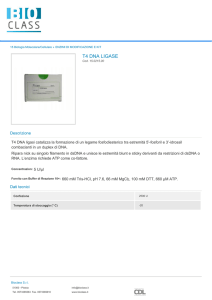
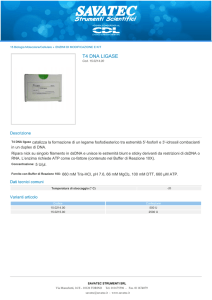
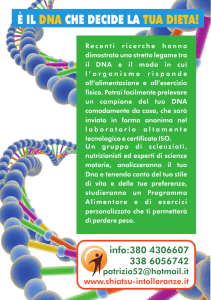
![mutazioni genetiche [al DNA] effetti evolutivi [fetali] effetti tardivi](http://s1.studylibit.com/store/data/004205334_1-d8ada56ee9f5184276979f04a9a248a9-300x300.png)
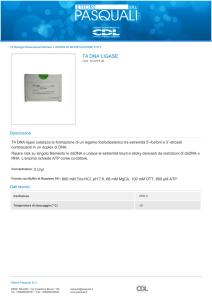
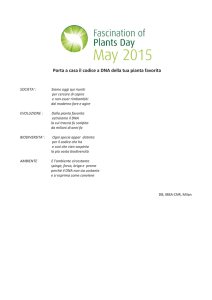
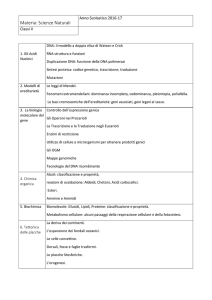
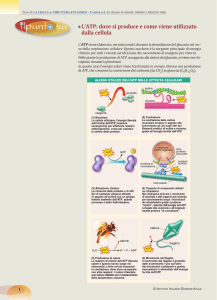
![(Microsoft PowerPoint - PCR.ppt [modalit\340 compatibilit\340])](http://s1.studylibit.com/store/data/001402582_1-53c8daabdc15032b8943ee23f0a14a13-300x300.png)
